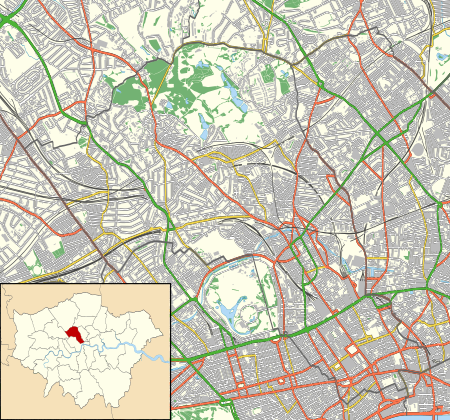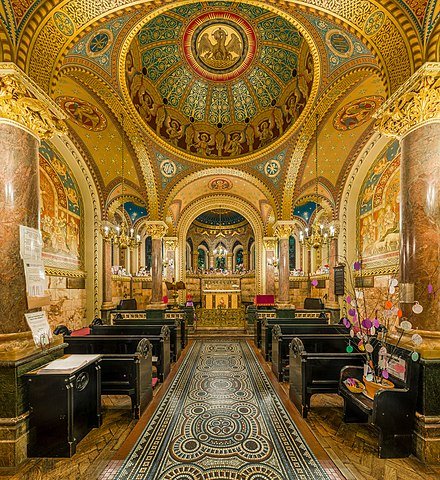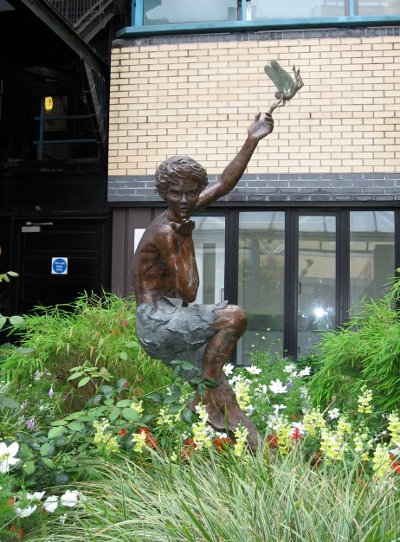British Heritage
Remember, Cherish, Learn.
beta
Great Ormond Street Hospital
A Bastion of British Medical Heritage.
Great Ormond Street Hospital (GOSH), informally known and affectionately celebrated, stands as an emblem of British medical heritage and a testament to the nation's commitment to the welfare of children. Born out of a passion for paediatric healthcare and a determination to defy medical norms of the 19th century, this renowned institution has made an indelible impact on child health globally.
On 14th February 1852, the Hospital for Sick Children, as GOSH was originally named, emerged from the vision of Dr Charles West. It marked the establishment of the first hospital in England to provide in-patient beds specifically for children.
This pioneer of paediatric care launched with just ten beds, but quickly expanded into one of the world's leading children's hospitals. This was in part due to the patronage of Queen Victoria and the personal efforts of Charles Dickens, a close friend of Dr West. These early endorsements laid a firm foundation for the hospital's enduring legacy.
The post-war climate of Britain led to the nationalisation of GOSH in 1948, positioning it within the framework of the newly formed National Health Service (NHS). This integration within the NHS bolstered GOSH's growth, though it also led to constraints on private fundraising for the hospital. This challenge was overcome through the hospital's ability to receive pre-existing legacies.
In the latter part of the 20th century, GOSH continued to benefit from high-profile support. Audrey Callaghan, wife of former Prime Minister James Callaghan, served in various leadership capacities within the hospital, whilst Diana, Princess of Wales, lent her royal patronage to GOSH as president from 1989 until her untimely death.
Situated in the heart of Bloomsbury, GOSH has built a reputation as an epicentre of child heart surgery and heart transplantation. Its research efforts and groundbreaking medical breakthroughs have solidified this status.
In 1962, GOSH unveiled the first heart and lung bypass machine for children, revolutionising the field of paediatric cardiology. Collaborating with celebrated children's author Roald Dahl, the hospital developed an improved shunt valve for children suffering from hydrocephalus, a condition causing dangerous buildup of fluid in the brain.
GOSH has also been at the forefront of vaccine development and gene therapy, conducting the first UK clinical trials of the rubella vaccine and delivering the first bone marrow transplant and gene therapy for severe combined immunodeficiency.
These innovations have been further amplified through GOSH's association with University College London (UCL). The partnership with the UCL Great Ormond Street Institute of Child Health has fostered the largest centre for research and postgraduate teaching in children's health in Europe.
One of GOSH's most cherished contributions to its heritage came in 1929, when J. M. Barrie bestowed the copyright to his beloved work, Peter Pan, on the hospital. This gift provided an enduring and significant source of income, enabling GOSH to continue advancing child health.
GOSH has also been the recipient of generous donations through the Great Ormond Street Hospital Children's Charity. This fundraising entity bolsters the hospital's ability to stay at the cutting edge of child healthcare by funding redevelopment projects, procuring advanced medical equipment, and providing accommodation for families and staff.
A diverse array of charity events, ranging from the 'Jeans for Genes' campaign, the 'charity of the season' partnership with Arsenal F.C., to various charity singles have aided in raising millions for GOSH.
In the midst of its scientific endeavours, GOSH also harbours an architectural gem in the form of St. Christopher's Chapel. Decorated in the Byzantine style, this Grade II* listed building provides pastoral care to ill children and their families. This spiritual oasis, with its childhood-related themes, adds another layer to GOSH's rich legacy.
When the hospital underwent redevelopment in the late 1980s, meticulous effort was made to safeguard the chapel. It was moved via a 'concrete raft' to its current location, with its stained glass and furniture carefully restored. The chapel was reopened by Diana, Princess of Wales, in 1994, reaffirming its significance in GOSH's story.
GOSH's historical legacy has been meticulously preserved, with the hospital's archives providing valuable insight into its evolution. Admission records dating back to 1852 are available for research, illuminating the journey from a modest 10-bed facility to a globally-renowned paediatric healthcare centre.
Great Ormond Street Hospital embodies the spirit of innovation, resilience, and compassion that has defined British healthcare for centuries. As it continues to forge new paths in paediatric medicine, its enduring legacy, symbolised by its breakthroughs, its benefactors, and its commitment to holistic care, remains a pivotal part of Britain's heritage. In the realms of medicine and beyond, GOSH stands as a beacon of the nation's unwavering dedication to the health and welfare of its youngest citizens.
A Pioneering Vision
On 14th February 1852, the Hospital for Sick Children, as GOSH was originally named, emerged from the vision of Dr Charles West. It marked the establishment of the first hospital in England to provide in-patient beds specifically for children.
This pioneer of paediatric care launched with just ten beds, but quickly expanded into one of the world's leading children's hospitals. This was in part due to the patronage of Queen Victoria and the personal efforts of Charles Dickens, a close friend of Dr West. These early endorsements laid a firm foundation for the hospital's enduring legacy.
Nationalisation and Growth
The post-war climate of Britain led to the nationalisation of GOSH in 1948, positioning it within the framework of the newly formed National Health Service (NHS). This integration within the NHS bolstered GOSH's growth, though it also led to constraints on private fundraising for the hospital. This challenge was overcome through the hospital's ability to receive pre-existing legacies.
In the latter part of the 20th century, GOSH continued to benefit from high-profile support. Audrey Callaghan, wife of former Prime Minister James Callaghan, served in various leadership capacities within the hospital, whilst Diana, Princess of Wales, lent her royal patronage to GOSH as president from 1989 until her untimely death.
Trailblazing Medical Breakthroughs
Situated in the heart of Bloomsbury, GOSH has built a reputation as an epicentre of child heart surgery and heart transplantation. Its research efforts and groundbreaking medical breakthroughs have solidified this status.
In 1962, GOSH unveiled the first heart and lung bypass machine for children, revolutionising the field of paediatric cardiology. Collaborating with celebrated children's author Roald Dahl, the hospital developed an improved shunt valve for children suffering from hydrocephalus, a condition causing dangerous buildup of fluid in the brain.
GOSH has also been at the forefront of vaccine development and gene therapy, conducting the first UK clinical trials of the rubella vaccine and delivering the first bone marrow transplant and gene therapy for severe combined immunodeficiency.
These innovations have been further amplified through GOSH's association with University College London (UCL). The partnership with the UCL Great Ormond Street Institute of Child Health has fostered the largest centre for research and postgraduate teaching in children's health in Europe.
The Legacy of Peter Pan and Philanthropy
One of GOSH's most cherished contributions to its heritage came in 1929, when J. M. Barrie bestowed the copyright to his beloved work, Peter Pan, on the hospital. This gift provided an enduring and significant source of income, enabling GOSH to continue advancing child health.
GOSH has also been the recipient of generous donations through the Great Ormond Street Hospital Children's Charity. This fundraising entity bolsters the hospital's ability to stay at the cutting edge of child healthcare by funding redevelopment projects, procuring advanced medical equipment, and providing accommodation for families and staff.
A diverse array of charity events, ranging from the 'Jeans for Genes' campaign, the 'charity of the season' partnership with Arsenal F.C., to various charity singles have aided in raising millions for GOSH.
Architectural Heritage and Spiritual Care
In the midst of its scientific endeavours, GOSH also harbours an architectural gem in the form of St. Christopher's Chapel. Decorated in the Byzantine style, this Grade II* listed building provides pastoral care to ill children and their families. This spiritual oasis, with its childhood-related themes, adds another layer to GOSH's rich legacy.
When the hospital underwent redevelopment in the late 1980s, meticulous effort was made to safeguard the chapel. It was moved via a 'concrete raft' to its current location, with its stained glass and furniture carefully restored. The chapel was reopened by Diana, Princess of Wales, in 1994, reaffirming its significance in GOSH's story.
Unveiling History
GOSH's historical legacy has been meticulously preserved, with the hospital's archives providing valuable insight into its evolution. Admission records dating back to 1852 are available for research, illuminating the journey from a modest 10-bed facility to a globally-renowned paediatric healthcare centre.
Conclusion
Great Ormond Street Hospital embodies the spirit of innovation, resilience, and compassion that has defined British healthcare for centuries. As it continues to forge new paths in paediatric medicine, its enduring legacy, symbolised by its breakthroughs, its benefactors, and its commitment to holistic care, remains a pivotal part of Britain's heritage. In the realms of medicine and beyond, GOSH stands as a beacon of the nation's unwavering dedication to the health and welfare of its youngest citizens.
- Great Ormond Street Hospitalen.wikipedia.org










